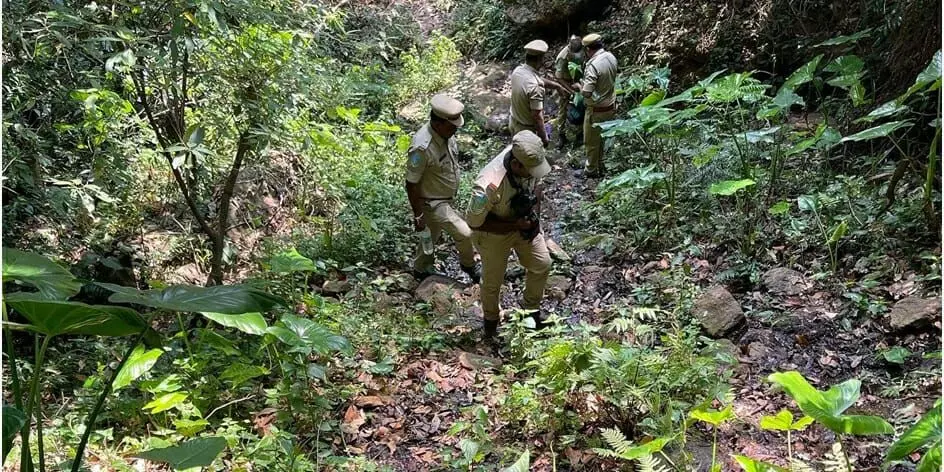Mission Conserve Eastern Ghats: Vizag forest division project aims to conserve biodiversity of Eastern Ghats
A few months ago, a plan was conceptualised to focus on conserving native species of the biodiversity-rich belt of the Eastern Ghats. Many of these species are found in the Eastern Ghats only and hence require interventions to save them and propagate them in the future.
By Newsmeter Network
Visakhapatnam: To conserve the rich biodiversity of the Eastern Ghats and enhance its greenery through a people's movement, the Visakhapatnam forest division has come up with an initiative – 'Mission Conserve Eastern Ghats.' It was launched on Sunday on the eve of International Day for Biological Diversity.
A few months ago, a plan was conceptualised to focus on conserving native species of the biodiversity-rich belt of the Eastern Ghats. Many of these species are found in the Eastern Ghats only and hence require interventions to save them and propagate them in the future.
What is the mission?
It is an integrated mission to conserve natural resources, increase green cover, sustainable utilisation of non-timber forest products (NTFPs), tribal development, and step up efforts to reduce increasing temperature and pollution levels in the urban areas.
District forest officer, Visakhapatnam, Anant Shankar has appealed to society, NGOs, government institutions, public institutions, corporate sector, PSUs, educational institutes, the tourism sector, and others to come together and assist the forest department in this cause.
What are the objectives?
· Enhancing greenery and biodiversity in the Visakhapatnam city and surrounding forests.
· Initiating a people's movement in conserving biodiversity.
· Processing non-timber forest produce (NTFPs) and ensuring providing organic and pure forest products to the public.
· Assisting Etikoppaka traditional toys industry.
· Developing eco-tourism for public recreation in a sustainable manner with the involvement of local communities.
· Providing sustainable livelihoods to tribals through forestry and related activities.
· Initiating the fight against the plastic menace.
· Developing resilience against climate change and mitigating its impact.
· Ensuring moderation in temperature levels and reducing electricity costs in urban limits.
· Determining the status of biodiversity in the Eastern Ghats belt in northern Andhra Pradesh.
Activities to achieve objectives
· Collecting seeds, cuttings, and plants from the wild. Almost 125 species were collected from the forests of Visakhapatnam, Alluri Seetharam Raju, and the Anakapalli districts.
· Establishing modern nursery infrastructure like mist chambers, glasshouses, procuring root trainers, sprinklers, and employing the latest techniques to raise native trees on a mass scale.
· Coordinating with civil society and different stakeholders for contributing to the cause and encouraging public participation in various activities like collecting seeds, raising nurseries, raising and adopting plants by individuals or groups, and effective monitoring of raised species.
· Establishing a biodiversity centre at Kambalakonda Wildlife Sanctuary in coordination with the Dolphin Nature Conservation Society, Visakhapatnam, and state silviculturist Rajamahendravaram. This centre is proposed to be all-encompassing with the establishment of an arboretum, Ficus grove, Bambusetum, medicinal plants garden, herbal garden, Orchidarium, and butterfly garden. An interpretation centre for a better understanding of the Eastern Ghats and its rich biodiversity is also proposed at the site. Once developed, this will be the first such centre in Andhra Pradesh and a central tourism spot in the city of Visakhapatnam.
· To tap the potential of non-timber forest produce (NTFPs) of the Eastern Ghats, an NTFP Processing centre is proposed. It will focus on employing tribals and local forest-dwelling communities for collecting NTFPs and for processing them.
· Jackfruit, tamarind, terminalia, Aaonla (Usiri), and Bel (Maredu)-based products will be produced. Further, plates and bowls made of Adda (Bauhinia species) leaves will be produced to provide suitable alternatives to single-use plastics.
· The traditional handicraft of Etikoppaka is a forest-dependent activity and provides livelihood to more than 400 people in the village. To facilitate this traditional craft and ensure a proper supply of raw material, this mission will focus on the plantation of Wrightia tinctoria (Ankudu) tree species. Its wood is being used for making Etikoppaka toys and idols.
· Visakhapatnam is a coastal city that is often frequented by cyclones. There is an urgent need to make the city resilient to such natural disasters and the impacts of climate change. Nature-based solutions like the establishment of effective green barriers and ensuring carbon sequestration through plantations of suitable species will be promoted in the city and adjoining areas.
· Initiating surveys on the status of endemic flora and fauna of the Eastern Ghats and determining their status to take proper remedial actions to conserve these species in coordination with different national institutions like Botanical Survey of India, Wildlife Institute of India, and Andhra University.
· Providing capacity building and training to field staff of line departments, including forest, horticulture, agriculture, tribal, VMRDA, and others on raising suitable species to conserve biodiversity.
· Coordinate with district administration and various departments, public institutions, and civil society groups regarding pertinent issues of conservation and ensure mainstreaming of developmental activities towards biodiversity and environment conservation.